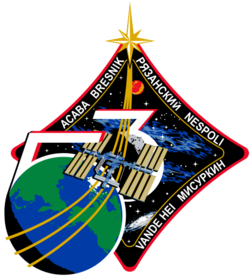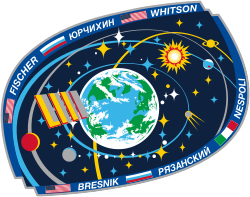Expedition 52
| Expedition 52 | |||
 | |||
| Uppdragsstatistik | |||
|---|---|---|---|
| Rymdstation: | ISS | ||
| Start: | 2 juni 2017[1] | ||
| Slut: | 3 september 2017 | ||
| Antal besättningsmedlemmar: | 6 st | ||
| Rymdpromenad | |||
| Antal rymdpromenader: | 1 st | ||
| Total tid: | 7 h, 34 min | ||
| Transport | |||
| Uppskjutning: | med Sojuz MS-03, Sojuz MS-04, Sojuz MS-05 | ||
| Uppskjutningsplats: | Kosmodromen i Bajkonur | ||
| Landning: | med Sojuz MS-04, Sojuz MS-05 | ||
| Landningsplats: | Kazakstan | ||
| Kronologi | |||
| |||

Expedition 52 var den 52:e expeditionen till Internationella rymdstationen (ISS). Expeditionen började 2 juni 2017 då delar av Expedition 51s besättning återvände till jorden med Sojuz MS-03.
Sergej Ryzjikov, Randolph Bresnik och Paolo Nespoli anlände till stationen med Sojuz MS-05 den 28 juli 2017.
Expeditionen avslutades den 3 september 2017 då Fjodor Jurtjichin, Jack D. Fischer och Peggy Whitson återvände till jorden med Sojuz MS-04.
Besättning
| Position | Första delen (2 juni - 28 juli 2017) | Andra delen (28 juli - 3 september 2017) |
|---|---|---|
| Befälhavare | Hans femte rymdfärd | |
| Flygingenjör 1 | Hans första rymdfärd | |
| Flygingenjör 2 | Hennes tredje rymdfärd | |
| Flygingenjör 3 | Hans andra rymdfärd | |
| Flygingenjör 4 | Hans andra rymdfärd | |
| Flygingenjör 5 | Hans tredje rymdfärd | |
Referenser
- ^ NASA's Space Station Expedition 52 Arkiverad 18 juli 2019 hämtat från the Wayback Machine., läst 3 juni 2017.
Externa länkar
| |||||||||||||||||||
Media som används på denna webbplats
The Expedition 53 crew insignia
- The International Space Station is our launch pad into the future of human space exploration. Collectively, our world stands at the cusp of incredible developments as a spacefaring species. Onboard the space station we continue to evolve the technologies vital to the sustainment and longevity of humans in the harsh realities of living without gravity or the protection of our atmosphere. These self-sustaining or regenerative technologies continually developed aboard the space station not only improve life here on Earth, but they are essential to human beings existence beyond low-Earth orbit (LEO).
- The space station is the linchpin for this next great phase of development and is instrumental in expanding the use of space, not only as a worldclass science laboratory, but also as a destination for next-generation space vehicles. This journey beyond LEO is depicted in the Expedition 53 patch as we, the crew, will endeavor to accomplish the work that allows future missions to further explore our solar system. This journey will only be accomplished as an international team, represented by our multinational crew as well as by the many countries depicted on the globe.
- The myriad of stars represent the untold number of passionate and supremely dedicated people that endeavor across the planet daily to make the space station the amazing vehicle it is as well as prepare us for the next great steps forward in space exploration.
Official crew patch of Expedition 51 during their mission to the International Space.
- From as early as the 11th century, coats of arms have been used as emblems representing groups as small as families to as large as countries. The Expedition 51 patch is designed as a modernized international coat of arms, blending the traditional shield shape with our modernized symbol of achievement, the International Space Station. The background represents our home world and its inhabitants on the left, and outer space to the right. The bi-color International Space Station is the bridge between the two, symbolizing the benefits on Earth of space research, and at the same time our mission to explore deeper into space, on a path to further discovery and knowledge.
The Expedition 52 crew insignia
- Our planet is shown surrounded by an imaginary constellation shaped like a house, depicting the theme of the patch: “The Earth is our home.” It is our precious cradle, to be preserved for all future generations. The house of stars just touches the Moon, acknowledging the first steps we have already taken there, while Mars is not far away, just beyond the International Space Station, symbolized by the Roman numeral “LII,” signifying the expedition number.
- The planets Saturn and Jupiter, seen orbiting farther away, symbolize humanity’s exploration of deeper space, which will begin soon. A small Sputnik is seen circling the Earth on the same orbit with the ISS, bridging the beginning of our cosmic quest till now: Expedition 52 will launch in 2017, sixty years after that first satellite.
- Two groups of crew names signify the pair of Soyuz vehicles that will launch the astronauts of Expedition 52 to the Station.
The Expedition 52 crew members (front row, from left) are Commander Fyodor Yurchikhin and NASA astronaut Randy Bresnik. In the back row (from left) are, NASA astronauts Jack Fischer and Peggy Whitson, European Space Agency astronaut Paolo Nespoli and Roscosmos cosmonaut Sergey Ryazanskiy.






